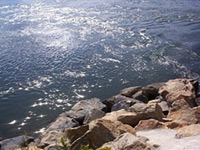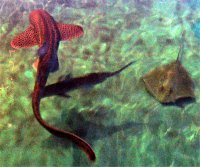Marine Ecosystems

Marine ecosystems are a part of the largest aquatic system on the planet, covering over 70% of the Earth's surface. The habitats that make up this vast system range from the productive nearshore regions to the barren ocean floor. Some examples of important marine ecosystems are:
- Oceans
- Estuaries and Salt Marshes
- Coral Reefs and Other Tropical Communities (Mangrove Forests)
- Coastal areas like Lagoons, Kelp and Seasgrass Beds and Intertidal systems (rocky, sandy, and muddy shores)
Marine ecosystems are home to a host of different species ranging from tiny planktonic organisms that comprise the base of the marine food web (i.e., phytoplankton and zooplankton) to large marine mammals like the whales, manatees, and seals. In addition, many fish species reside in marine ecosystems including flounder, scup, sea bass, monkfish, squid, mackerel, butterfish, and spiny dogfish. Birds are also plentiful including shorebirds, gulls, wading birds, and terns. Some marine animals are also endangered including whales, turtles, etc. In summary, many animal species rely on marine ecosystems for both food and shelter from predators.

Marine ecosystems contain several unique qualities that set them apart from other aquatic ecosystems, the key factor being the presence of dissolved compounds in seawater, particularly salts. This total gram weight of dissolved substances (salts) in one kg of seawater is referred to as salinity. In general 85% of the dissolved substances are Sodium (Na) and Chlorine (Cl) in seawater. On average seawater has a salinity of 35 parts per thousand grams (ppt) of water. These dissolved compounds give seawater its distinctive "salty" taste, affect species composition of particular marine habitats, and prevent oceans from freezing during the winter. Daily changes in factors such as weather, currents, and seasons as well as variations in climate and location will cause salinity levels to vary among different marine ecosystems. In areas such as estuaries, tidal marshes, and mangrove forests, tidal and freshwater influences from river and streams makes it necessary for marine organisms to adapt to a wide range of salinity levels. These organisms such as mussels, clams, and barnacles, are called euryhaline (salt tolerant) organisms. Other organisms, in particular finfish, are unable to tolerate such changes in salinity. These organisms are considered to be stenohaline (salt intolerant). These species require more constant levels of salinity, forcing them to either migrate to new areas when fluctuations in salinity levels occur or to seek out areas where salinity change is minimal (e.g., the deep ocean).

Like other aquatic ecosystems, marine ecosystems require nutrients and light to produce food and energy. However, both nutrients and light are limiting factors in marine ecosystem productivity. Like many other aquatic plants, photosynthetic marine organisms (i.e., phytoplankton) rely upon sunlight and chlorophyll a to absorb visible light from the sun as well as nitrogen (N), phosphorus (P), and silicon (Si) to generate food and promote growth and reproduction. However, the amount of light penetrating the ocean surface tends to decrease with increasing water depth, therefore photosynthesis can only take place within a small band near the surface of the water (called the photic zone). In addition, nutrient availability often varies significantly from place to place. For example, in the open ocean, nutrient levels are often very poor causing primary production to be very low. In contrast, nearshore waters such as estuaries and marshes are often rich in nutrients, allowing primary production to be very high. In some instances, nearshore ecosystems have an excess of nutrients due to runoff and other terrestrial sources. Excess nutrients can cause an over-stimulation of primary production, depleting oxygen levels and causing eutrophic conditions to occur in coastal habitats.
Marine ecosystems are very important in to the overall health of both marine and terrestrial environments. According to the World Resources Center, coastal habitats alone account for approximately 1/3 of all marine biological productivity, and estuarine ecosystems (i.e., salt marshes, seagrasses, mangrove forests) are among the most productive regions on the planet. In addition, other marine ecosystems such as coral reefs, provide food and shelter to the highest levels of marine diversity in the world.

The diversity and productivity of marine ecosystems are also important to human survival and well-being. These habitats provide us with a rich source of food and income, and support species that serve as animal feed, fertilizers for crops, additives in foods (i.e., ice-cream) and cosmetics (i.e., creams and lotions). Areas such as mangroves, reefs, and seagrass beds also provide protection to coastlines by reducing wave action, and helping to prevent erosion, while areas such as salt marshes and estuaries have acted as sediment sinks, filtering runoff from the land. Despite the importance of marine ecosystems, increased human activities such as overfishing, coastal development, pollution, and the introduction of exotic species have caused significant damage and pose a serious threat to marine biodiversity. Please visit USEPA's Web site for resources on Marine Ecosystems, Oceans, Coasts and Estuaries, and Marine Species at Risk. Also, read about EPA's 2007 Report on the Environment Coastal Benthic Community indicator.
For more information about marine ecosystems please visit the following
websites:
- Learn about EPA's response to the BP oil spill in the Gulf of Mexico
- Learn about the Federal Government's coordinated response to the BP oil spill in the Gulf of Mexico
- EPA Region 10's Marine Species at Risk - learn what we are doing to protect this resource!
- NOAA Status of Marine Fisheries Resources (with pictures and life history of fish)
- NOAA Marine Ecosystem Division
- NOAA Coastal Ecosystem Science
- NOAA Large Marine Ecosystems: A Breakthrough Concept for Ecosystem Management
- NOAA Large Marine Ecosystems of the World
- NOAA Conserving the Nation's Living Marine Ecosystems
- World Resources Institute Coastal and Marine Resources: Marine Biodiversity
- Missouri Botanical Gardens - Marine Ecosystems
- The Encyclopedia of Earth - Marine Ecosystem Services
![[logo] US EPA](https://cybercemetery.unt.edu/archive/oilspill/20120921180405im_/http://www.epa.gov/epafiles/images/logo_epaseal.gif)